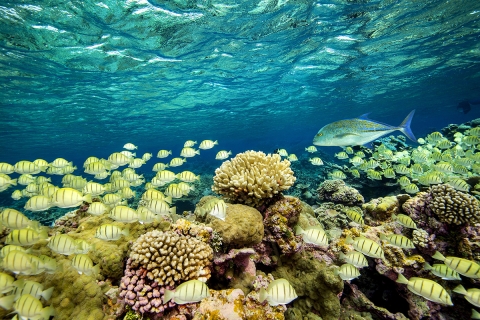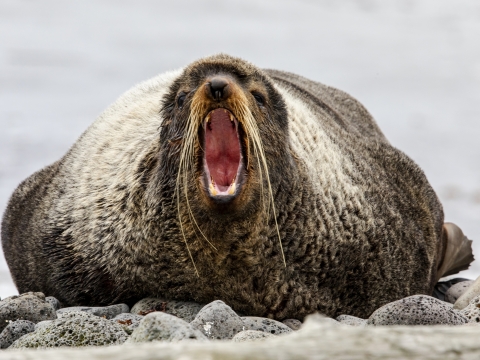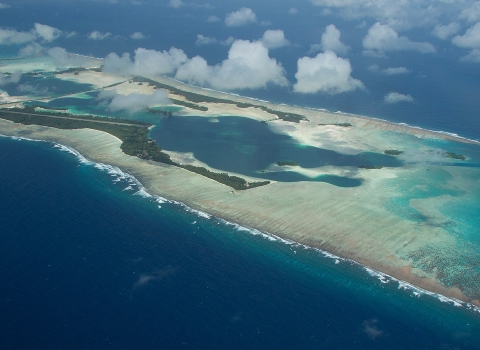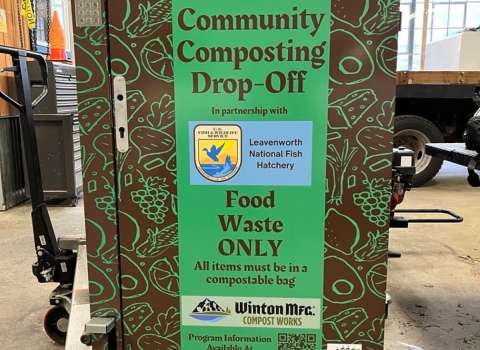Oceans cover almost three-quarters of Earth’s surface and contain about 97 percent of the planet’s water – and we are just beginning to understand how ocean creatures are interconnected with one another and with us.
While the National Wildlife Refuge System is best known for conserving land habitats, the system also conserves vast marine and coastal habitats from above the Arctic Circle to south of the equator. Coastal and marine conservation helps protect communities from flooding, storm surges, saltwater intrusion and invasive species invasive species
An invasive species is any plant or animal that has spread or been introduced into a new area where they are, or could, cause harm to the environment, economy, or human, animal, or plant health. Their unwelcome presence can destroy ecosystems and cost millions of dollars.
Learn more about invasive species , while providing habitat for sea turtles, marine mammals, shorebirds and fish.
Marine and coastal areas within the Refuge System provide countless opportunities for recreation. From fishing and boating to diving and wildlife viewing, there are many ways you can make the most of the coast.
By the Numbers
More than 180 national wildlife refuges conserve marine, coastal and Great Lakes habitats.
759 million cooperatively managed acres of submerged lands and waters
5 marine national monuments
- More than 150 marine protected areas as part of a worldwide effort
Coastal Wildlife Refuges
Alaska
Alaska Maritime National Wildlife Refuge stretches 5,000 miles from the Gulf of Alaska, through the Aleutian Islands, and up the state’s west coast. It includes 2,500+ islands, islets, spires, rocks and reefs.
California
About 28 miles west of San Francisco, Farallon Islands National Wildlife Refuge provides essential haul-out and breeding habitat for five species of marine mammals.
Florida
Archie Carr National Wildlife Refuge, along 20.5 miles of beach on Florida’s east coast, conserves some of the most significant loggerhead sea turtle nesting habitat in the world.
Marine Areas
The Refuge System cooperates with state and territorial governments, other federal agencies and non-governmental partners on management, research and exploration, enforcement and logistical support to manage more than 759 million acres of submerged lands and waters, primarily in marine national monuments. The Refuge System conserves more than 150 marine protected areas that are part of a broader network of federal, state, local and tribal marine protected areas.
Marine and Coastal Conservation
Cooperative conservation extends beyond federal lands to community-driven voluntary programs across a mosaic of land ownership, from private, state, and tribal to public. Through the U.S. Fish and Wildlife Service’s Coastal Program and National Wetlands Coastal Grant program, experts provide coordination, technical and financial support to hundreds of partners and communities to develop solutions to local coastal conservation challenges. This collaborative approach ensures a thriving and resilient future for our nation’s coastal habitats, species and people.
Learn how plastics, cigarette butts, straws and other trash discarded in the world’s oceans impact fish and animals in the Refuge System and what you can do about it.
- Urban Renewal
- Aging dams are a safety hazard for communities. In New Haven, Connecticut, the Coastal Program and its partners completed a dam removal that created healthy habitat for wildlife and recreational space for people.
Saving the Salt Bayou
Working with partners, the Coastal Program is helping to protect valuable oil and gas infrastructure near Port Arthur, Texas, while ensuring wildlife and people have a place to thrive.
Stewardship Responsibilities for Marine Species
The Marine Mammal Protection Act (MMPA) protects all marine mammals, including cetaceans (whales, dolphins and porpoises), pinnipeds (seals and sea lions), sirenians (manatees and dugongs), sea otters and polar bears within the waters of the United States.
The act makes it illegal to “take” “take”
The term “take” means to harass, harm, pursue, hunt, shoot, wound, kill, trap, capture, or collect, or to attempt to engage in any such conduct.
Learn more about “take” marine mammals without a permit. This means people may not harass, feed, hunt, capture, collect or kill any marine mammal or part of a marine mammal.
The U.S. Fish and Wildlife Service (Service) and NOAA’s National Marine Fisheries Service (NMFS) share responsibilities for the protection, conservation and management of marine mammals under the MMPA and Endangered Species Act . The Fish and Wildlife Service works internationally through treaties like CITES (the Convention on International Trade in Endangered Species of Wild Fauna and Flora) for control the import and export of all marine mammal species, and has responsibility for walrus, polar bears, sea otters, dugongs and several manatee species.
The Fish and Wildlife Service and NMFS also share federal jurisdiction for sea turtles, with the Fish and Wildlife Service having lead responsibility on the nesting beaches and the National Marine Fisheries Service leading on the marine environment. Federal responsibilities and programs include development and implementation of recovery plans, land acquisition, cooperative programs with states, consultation with other federal agencies, international cooperation; promulgation of regulations to reduce take; permitting of activities involving take; and development of habitat conservation plans.
The National Marine Fisheries Service has responsibility for seals, sea lions, cetaceans, and saltwater anadromous fish species, while the USFWS manages catadromous fish species. The Marine Mammal Commission (MMC) was later established as an independent federal agency to review and make recommendations on the policies and actions of the Fish and Wildlife Service and NOAA. Coordination among these agencies is critical to providing the best management of these marine mammals. The MMC produces annual reports to Congress describing its activities and accomplishments. The Fish and Wildlife Service works closely with NOAA to monitor and protect marine mammals that haul out and breed on national wildlife refuges.
Fish and Wildlife Service
Fisheries and Aquatic Conservation (Catadromous species)
Alaska Region Marine Mammals Management
Florida manatee information
Ventura Field Office – Common tern, Maine Coastal Islands National Wildlife Refuge. (Photo: USFWS)









